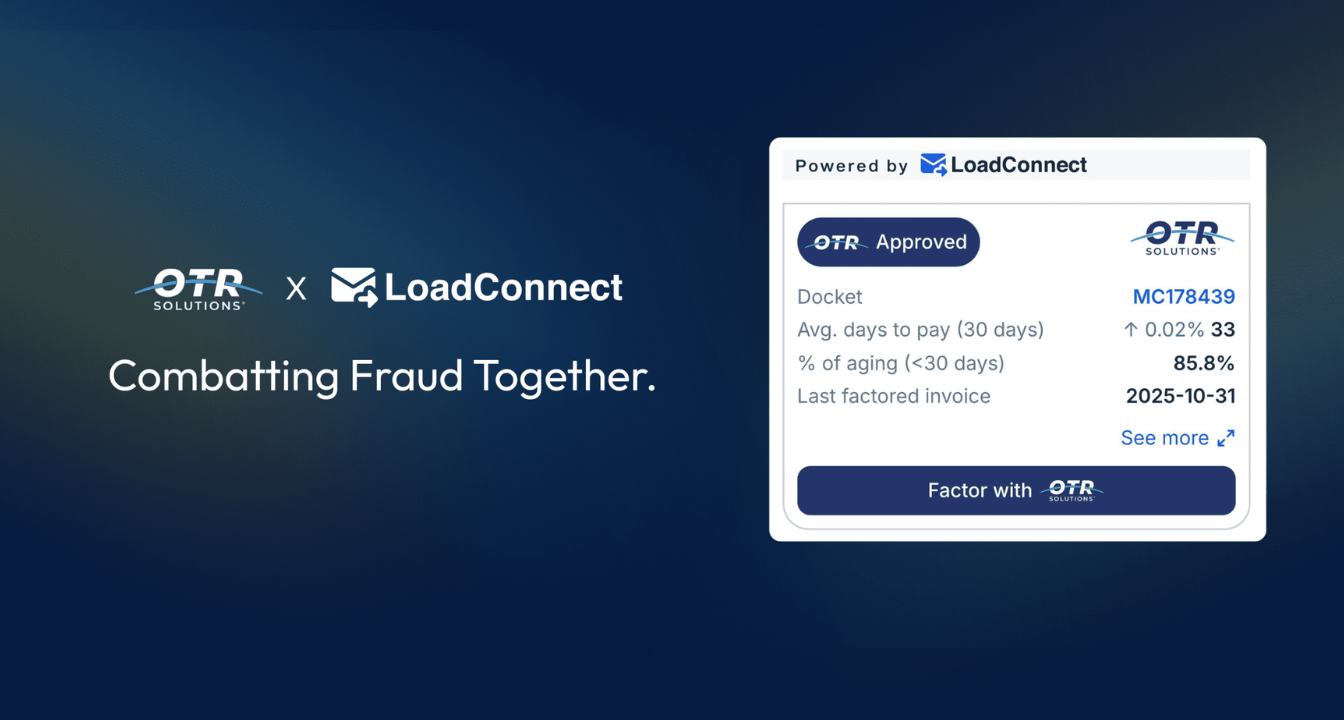Tariffs are taxes on imported goods that create a ripple effect throughout freight transportation. The trucking tariff impact affects everything from fuel costs to available loads, directly influencing whether you're running profitable miles or sitting empty waiting for freight. The 2025 trucking tariff impact has been severe, with record-high tariff levels disrupting trade flows and freight demand. OTR Solutions helps carriers navigate these challenging times with support and services designed exclusively for owner-operators and carriers across the country.
Key Takeaways:
- Record tariff levels have disrupted established freight patterns – reducing load availability on key shipping lanes that carriers depend on for consistent revenue.
- Agricultural retaliation has significantly decreased export freight from America's heartland – affecting truckers who regularly haul grain, livestock, and farm products to ports.
- Cross-border restrictions have complicated Canada-U.S. trade routes – creating uncertainty for carriers who specialize in international freight.
- Fuel price pressures from energy-related trade disputes could increase operating costs – while freight demand remains constrained by ongoing trade tensions.
How Tariffs Impact Trucking Industry: 2025 Updates
Current tariff policies are creating immediate challenges for trucking companies through increased costs and disrupted trade flows.
2025 Policy Shifts:
The Trump administration has implemented the highest tariff rates in over a century, creating unprecedented volatility in freight markets and cross-border trade flows.
- Heavy-Truck Import Tariff: The U.S. imposed a 25% tariff on imported heavy trucks starting October 1, 2025, increasing the landed cost of trucks brought from abroad and forcing carriers to reexamine sourcing and timing for equipment purchases.
- Steel, Aluminum & Component Tariffs: Imports of steel, aluminum, and copper derivatives now face 50% tariffs under Section 232, pushing up costs for chassis, frames, body parts, and many repair components in the supply chain.
- De Minimis / Small-Parcel Exemptions Removed: Starting May 2, 2025, imports from China and Hong Kong below the typical de minimis $800 exemption became subject to duties. On August 29, 2025, the U.S. suspended de minimis treatment globally, meaning nearly all small parcels could carry tariffs.
- Canada & Mexico Tariffs: Earlier in 2025, tariffs of 25% were applied to most goods from Canada and Mexico, with energy exports from Canada facing 10% in some cases. Canada dropped many retaliatory tariffs on September 1 but retained 25% duties on U.S. steel, autos, and aluminum.
- Reciprocal & Baseline Tariffs: A baseline "reciprocal" tariff regime introduced a 10% default tariff plus country-specific adjustments. Some imports subject to Section 232 (like steel, autos) are excluded from stacking, making tariff forecasting more complex.
What Are Trucking Tariffs and Why Do They Matter?
Tariffs are taxes governments place on imported goods, making those products more expensive for buyers. The trucking industry faces unique exposure to tariff changes because freight transportation sits at the intersection of all international trade, creating immediate impacts through:
- Reduced freight volumes – Fewer goods crossing borders means fewer loads available for carriers
- Higher equipment costs – Tariffs on steel and truck parts increase purchase and maintenance expenses
- Fuel price volatility – Trade disputes affecting energy imports create unpredictable diesel costs
- Shifting demand patterns – Freight routes change as companies seek alternative suppliers to avoid tariffed goods
How Tariffs Impact Trucking Costs and Operations
Tariff policies create cascading effects throughout the transportation industry, raising operational costs while simultaneously reducing freight opportunities.
Higher Equipment Costs
Tariffs on steel, aluminum, imported components, and even finished trucks raise the upfront cost of acquiring vehicles and chassis. Carriers need to compare the duty-adjusted cost of imports versus domestic builds and reconsider timing or ordering windows to manage these increased expenses effectively.
Increased Maintenance Costs
Parts such as brake systems, electronics, body panels, sensors, and structural parts become more expensive under tariff regimes. This inflation in repair budgets can prompt deferred maintenance, which ends up increasing downtime, breakdowns, and replacement costs later.
Operational Disruptions
Tariff changes often bring new compliance burdens, changed documentation, lane rerouting, and elongated border inspections. Freight patterns shift and previously dependable lanes may dry up, forcing carriers to stay alert to lane changes and re-optimize routing to avoid inefficiencies.
How Tariffs Influence Fuel Prices
Tariff policies create ripple effects throughout global energy markets, directly impacting the diesel fuel that powers America's freight network.
Global Trade and Fuel Volatility
Disruptions to energy trade, sanctions, or shifts in crude supply expectations alter global oil pricing and market sentiment. Diesel follows those swings, especially in tight markets, meaning even small changes in supply ripple into your fuel bill mid-week.
Domino Effect on Carrier Costs
Fuel represents the largest expense for most carriers:
- 20-30% of operating costs – Fuel dominates carrier budgets
- Margin squeeze – A 10-cent per gallon increase reduces annual profits by thousands
- Budget uncertainty – Tariff volatility makes fuel expense planning nearly impossible
- Contract risks – Fixed-rate contracts become losers when fuel prices spike unexpectedly
Beat volatile fuel costs with the OTR Fuel Card. Average savings of $0.50 per gallon at over 2,500 locations help maintain profitability when external factors push diesel prices higher.
How Tariffs Affect Freight Demand and Volumes
Tariffs create a domino effect that starts with higher consumer prices and ends with fewer loads available for carriers.
Reduced Consumer Demand
When tariffs raise prices on imported goods, end consumers often pull back, meaning fewer orders, scaled-back production, and lower freight volume on many lanes that depend on imported or tariff-impacted goods.
Fluctuating Freight Flows
Shippers may reconfigure where goods come from, avoiding high-tariff regions and rerouting container traffic to different ports, rail hubs, and lanes. Drayage and intermodal adjust first, so carriers should watch these shifts and reposition quickly when freight patterns change.
Lower Carrier Profitability
Rising equipment and parts costs plus looser freight availability compress margins for carriers, hitting owner-operators and small fleets hardest. These challenges mirror broader freight market pressures that have affected the industry in recent years.
The Impact on Drivers and the Workforce
Tariff-driven uncertainty doesn't just affect carriers; it filters down to driver assignments, pay, and schedule stability.
Reduced Hours and Pay
When fewer loads are available, dispatches shrink, and driver miles fall, pushing driver pay lower, especially for those working spot runs without guaranteed miles.
Job Insecurity and Layoffs
If market pressure lasts, carriers may reduce shifts, consolidate roles, or cut headcount, creating uncertainty about long-term career prospects. These disruptions add another layer to ongoing supply chain challenges that carriers must navigate.
How Carriers Can Stay Resilient Amid Tariff Challenges
Resilience comes from combining financial tools, fuel strategy, lane flexibility, and smart decision-making.
Improve Cashflow with Factoring
Tariff-driven market uncertainty creates cashflow challenges when freight volumes fluctuate. True Non-Recourse Factoring provides same-day funding on approved and processed invoices with no chargebacks, giving you the financial flexibility to cover expenses and respond to changing conditions without waiting on broker payments.
Cut Fuel Costs with a Discount Fuel Card
When tariffs affect diesel prices, controlling fuel expenses becomes essential. Fuel cards can deliver significant per-gallon savings at in-network truck stops, helping protect your margins when fuel costs are unpredictable. Many fuel card programs include fuel finder tools that help you identify the lowest-priced stops along your route. Effective fleet and fuel management strategies become critical during periods of market uncertainty.
Diversify Freight and Lanes
Don't depend on a single port, region, or commodity. Build flexibility by working with multiple brokers and shippers and watching trade flow trends so you can pivot lanes before they collapse.
Leverage Technology
Use the OTR Mobile App and Client Portal to track invoices in real time and view invoice history and payment status. The 24/7 broker check feature helps you make more informed decisions about which loads to accept, especially on lanes affected by tariff disruptions. Access to real-time payment data and broker approval status helps you avoid risky situations and optimize your operational costs.
Navigating Tariffs with OTR Solutions
Tariffs raise costs, shake freight flows, and cut margins, but carriers can still maintain stable operations with the right support. OTR gives you factoring, fuel savings, and tools that protect your cashflow while you respond fast to market changes. Ready to strengthen your operation? Apply for the OTR Fuel Card to start saving on fuel costs, or get started with True Non-Recourse Factoring to secure your cashflow today.
Frequently Asked Questions
What does "trucking tariff impact" mean?
It refers to how import tariffs affect trucking costs, freight volumes, and carrier profitability.
How do tariffs impact truck prices?
Tariffs on steel, aluminum, and imported truck parts increase the cost of new trucks, trailers, and repairs.
Do tariffs affect fuel prices?
Yes. Policies like energy tariffs shift global trade flows, raising diesel prices and operating costs for carriers.
How can carriers offset tariff-related costs?
By using factoring, discounted fuel programs, and smarter planning tools, carriers can reduce risk and protect margins.
Related articles.
A smart move in the right direction.
New to the business or expanding your fleet, we only succeed when you do. We’ll bring the tools and support. You bring the hustle. Let’s move forward together.






